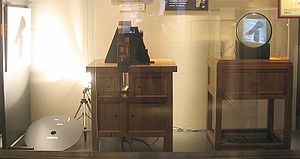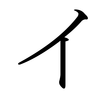
Kenjiro Takayanagi
Encyclopedia
was a Japan
ese pioneer in the development of television
. Although he failed to gain much recognition in the West
, he built the world's first all-electronic television receiver, and is referred to as "the father of Japanese television".
 In 1925, Takayanagi began research on television after reading about the new technology in a French magazine. He developed a system similar to that of John Logie Baird
In 1925, Takayanagi began research on television after reading about the new technology in a French magazine. He developed a system similar to that of John Logie Baird
, using a Nipkow disk
to scan the subject and generate electrical
signals
. But unlike Baird, Takayanagi took the important step of using a cathode ray tube
to display the received signal, thereby developing the first "all-electronic" television set. On December 25, 1926, Takayanagi successfully demonstrated his system at Hamamatsu Industrial High School, where he was teaching at the time (the school is now the Faculty of Engineering at Shizuoka University
). The first picture he transmitted was of the Japanese katakana
character made up of 40 scan lines. This was several months before Philo T. Farnsworth demonstrated his first fully electronic system in San Francisco on September 7, 1927, which did not require a Nipkow disk. (See History of television
made up of 40 scan lines. This was several months before Philo T. Farnsworth demonstrated his first fully electronic system in San Francisco on September 7, 1927, which did not require a Nipkow disk. (See History of television
.)
In subsequent years, Takayanagi continued to play a key role in the development of television at NHK
(the Japan Broadcasting Corporation) and then at JVC
(Victor Company of Japan), where he eventually became vice president. He was also involved in the development of color television and video tape recorder
s. He died of pneumonia
in 1990 at the age of 91.
in 1989.. His work on electronic television was named an IEEE Milestone in 2009.
Japan
Japan is an island nation in East Asia. Located in the Pacific Ocean, it lies to the east of the Sea of Japan, China, North Korea, South Korea and Russia, stretching from the Sea of Okhotsk in the north to the East China Sea and Taiwan in the south...
ese pioneer in the development of television
Television
Television is a telecommunication medium for transmitting and receiving moving images that can be monochrome or colored, with accompanying sound...
. Although he failed to gain much recognition in the West
Western world
The Western world, also known as the West and the Occident , is a term referring to the countries of Western Europe , the countries of the Americas, as well all countries of Northern and Central Europe, Australia and New Zealand...
, he built the world's first all-electronic television receiver, and is referred to as "the father of Japanese television".
Career

John Logie Baird
John Logie Baird FRSE was a Scottish engineer and inventor of the world's first practical, publicly demonstrated television system, and also the world's first fully electronic colour television tube...
, using a Nipkow disk
Nipkow disk
A Nipkow disk , also known as scanning disk, is a mechanical, geometrically operating image scanning device, invented by Paul Gottlieb Nipkow...
to scan the subject and generate electrical
Electricity
Electricity is a general term encompassing a variety of phenomena resulting from the presence and flow of electric charge. These include many easily recognizable phenomena, such as lightning, static electricity, and the flow of electrical current in an electrical wire...
signals
Signal (electrical engineering)
In the fields of communications, signal processing, and in electrical engineering more generally, a signal is any time-varying or spatial-varying quantity....
. But unlike Baird, Takayanagi took the important step of using a cathode ray tube
Cathode ray tube
The cathode ray tube is a vacuum tube containing an electron gun and a fluorescent screen used to view images. It has a means to accelerate and deflect the electron beam onto the fluorescent screen to create the images. The image may represent electrical waveforms , pictures , radar targets and...
to display the received signal, thereby developing the first "all-electronic" television set. On December 25, 1926, Takayanagi successfully demonstrated his system at Hamamatsu Industrial High School, where he was teaching at the time (the school is now the Faculty of Engineering at Shizuoka University
Shizuoka University
Shizuoka University isa national university in Shizuoka, Japan.The university consists of six faculties; Humanities and Social Sciences, Education, Informatics, Science, Engineering and Agriculture...
). The first picture he transmitted was of the Japanese katakana
Katakana
is a Japanese syllabary, one component of the Japanese writing system along with hiragana, kanji, and in some cases the Latin alphabet . The word katakana means "fragmentary kana", as the katakana scripts are derived from components of more complex kanji. Each kana represents one mora...
character
 made up of 40 scan lines. This was several months before Philo T. Farnsworth demonstrated his first fully electronic system in San Francisco on September 7, 1927, which did not require a Nipkow disk. (See History of television
made up of 40 scan lines. This was several months before Philo T. Farnsworth demonstrated his first fully electronic system in San Francisco on September 7, 1927, which did not require a Nipkow disk. (See History of televisionHistory of television
The history of television records the work of numerous engineers and inventors in several countries over many decades. The fundamental principles of television were initially explored using electromechanical methods to scan, transmit and reproduce an image...
.)
In subsequent years, Takayanagi continued to play a key role in the development of television at NHK
NHK
NHK is Japan's national public broadcasting organization. NHK, which has always identified itself to its audiences by the English pronunciation of its initials, is a publicly owned corporation funded by viewers' payments of a television license fee....
(the Japan Broadcasting Corporation) and then at JVC
JVC
, usually referred to as JVC, is a Japanese international consumer and professional electronics corporation based in Yokohama, Japan which was founded in 1927...
(Victor Company of Japan), where he eventually became vice president. He was also involved in the development of color television and video tape recorder
Video tape recorder
A video tape recorder is a tape recorder that can record video material, usually on a magnetic tape. VTRs originated as individual tape reels, serving as a replacement for motion picture film stock and making recording for television applications cheaper and quicker. An improved form included the...
s. He died of pneumonia
Pneumonia
Pneumonia is an inflammatory condition of the lung—especially affecting the microscopic air sacs —associated with fever, chest symptoms, and a lack of air space on a chest X-ray. Pneumonia is typically caused by an infection but there are a number of other causes...
in 1990 at the age of 91.
Honors
Takayanagi was awarded the Grand Cordon of the Order of the Sacred TreasureOrder of the Sacred Treasure
The is a Japanese Order, established on January 4, 1888 by Emperor Meiji of Japan as the Order of Meiji. It is awarded in eight classes . It is generally awarded for long and/or meritorious service and considered to be the lowest of the Japanese orders of merit...
in 1989.. His work on electronic television was named an IEEE Milestone in 2009.
- Order of CultureOrder of CultureThe is a Japanese order, established on February 11, 1937. The order has one class only, and may be awarded to men and women for contributions to Japan's art, literature or culture; recipients of the order also receive an annuity for life...
External links
- Kenjiro Takayanagi: The Father of Japanese Television - A tribute to Kenjiro Takayanagi at the NHK website

